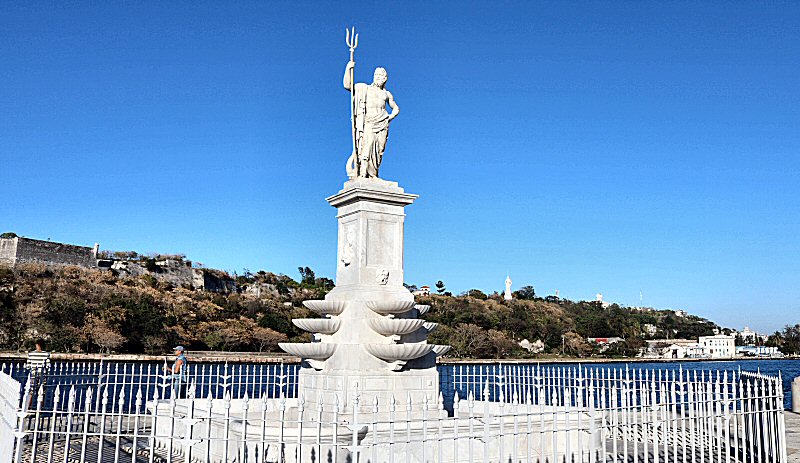
The Fuente de Neptuno is located at the
seaside of the Malecón (Avenue del Puerto) in front of the
Parque Luz y Caballero.
Along Avenue del Puerto stands a marble fountain, which, while not particularly resembling the surrounding area, is of high artistic value. It was originally built to enhance the city's beauty as part of urbanization planning.
HISTORY
The Governor and the Captain General Miguel Tacón (1834-1838) ordered to erect a fountain at the coastline close to the harbor that would supply drinking water to the ships and boats. It should have also a monumental character, thus contributing to his project about beautifying the city. It is argued that in fact the fountain was a part of a more comprehensive project that included a stone pier, called Muelle de Comercio, and a breakwater.
The surrounding of the fountain
was designed as a place of relaxation, where people would
enjoy the view of the sea, particularly the sunset on the
evenings, sitting on one of the six marble benches around
the fountain. The fountain with the statue was surrounded by
an iron railing attached to the pier. It was designed as
capable of providing drinking water through the pipes to
three small boats of the Captaincy and the Royal Treasury at
the same time. For this purpose, large bronze rings were
placed for the mooring of the ships on the edge of the
coast.
Over the years the fountain lost
its role as water provider, and deteriorated. The most
important mishap was the crash of the American brig JB
Hautington in 1845, in that some of the marble benches and a
part of the railing around the fountain were destroyed. In
1871 the city council decided to transfer the fountain to a
safe place, thus the tour of the fountain throughout the
city started. It was moved first to Alameda de la Reina
Isabel Segunda (current Paseo de Martí), then to the Parque
de la Punta where it stayed until 1912, when it was replaced
by the statue of José de la Luz y Caballero. The fountain
with the statue was stored in the Municipal Warehouse. In
1916 the first director of the National Museum of Havana
took the dusty and forgotten statue with its pedestal to the
institution to decorate the gallery on the ground floor. Two
years later Colonel José Ramón Villalón, the Secretary of
the Ministry of Public Works, moved it to the Parque Gonzalo
de Quesada, popularly known as Parque de Villalón, located
on Calzada between the streets C and D in Vedado in 1926.
Unfortunately, the trident of Neptune was broken, and the
fountain had lost its function as water supplier. In 1997 it
was moved to its current location after a meticulous
restoration.
Everyone in Havana calls the
fountain as Fuente de Neptuno, although its initial name was
Fuente de la Princesa, as it was brought to Havana in
commemoration of the oath as princess of the future Queen
Isabel II. Therefore, when the transfer of the fountain was
decided, Alameda de Isabel II (current Paseo de Martí)) was
the first localization that came in mind. The fountain was
also known as Fuente del Comercio, Fuente de Tacón, or Pila
de Neptuno. The Fuente de Neptuno should be not mixed with
another fountain with similar name that was called Neptunito
due to the smaller size of its Neptune statue. It was
located at the intersection of Alameda de Isabel II and San
Antonio (current Neptuno) streets, but it was demolished in
1840.
The fountain and the statue are
made of white Carrara marble. They have an approximate
weight of six tons. The fountain has a square base with the
statue in its center. The lower part of the pedestal
supports on its four sides three shells of different sizes,
the upper ones being the smallest ones. Above the shells,
there are the embossment of Triton, from the mouth of which
jets of water fall into the shells. Triton is a mythological
Greek god, the messenger of the sea. He was the son of
Poseidon and Amphitrite, god and goddess of the sea
respectively. He is usually represented as a merman that has
the body of a human at his upper part, but the tail of a
fish caudally.
On the large pedestal stands the life size
statue of Neptune, the god of freshwater and the sea in
Roman belief. He is also the counterpart
of the Greek god Poseidon. He is dressed as usual in Roman
Empire. His left hand is at his waist, while he holds a
trident with his right hand. The trident is a three-pronged
spear that was used for fishing, as well
as decorticator by the farmers to remove the leaves and
seeds from the stalks of some plants. Some gladiators were
also using the trident along with the net. The trident is
the weapon of Neptune and Poseidon. It is blamed that
Neptune was using it also to cause earthquakes. During the
restoration process of the statue the absent original
trident was replaced by its replica, following the original
proportions. The fountain is placed on a promontory at the
seashore, so that the square around it is convenient to
enjoy the sunset at a romantic evening.

